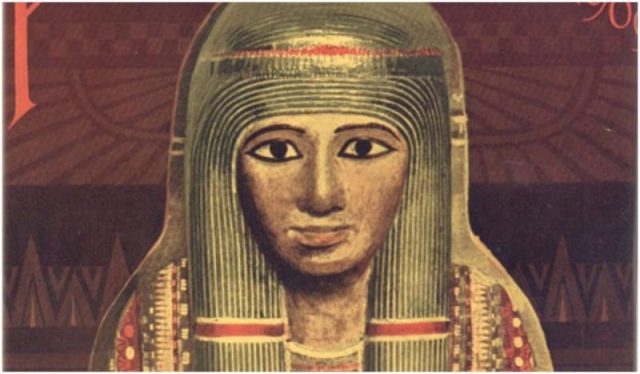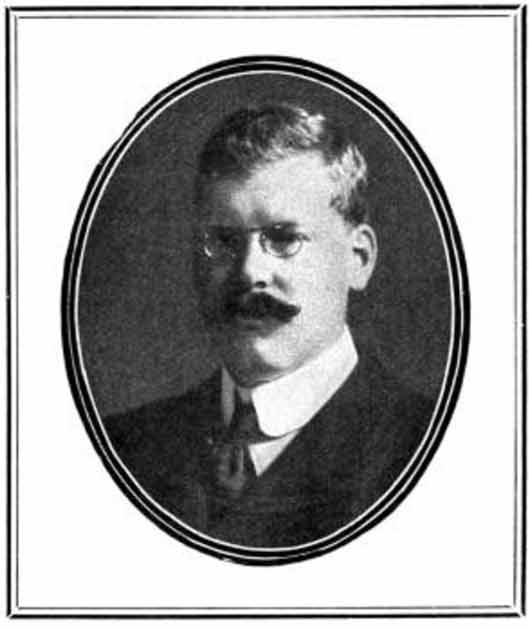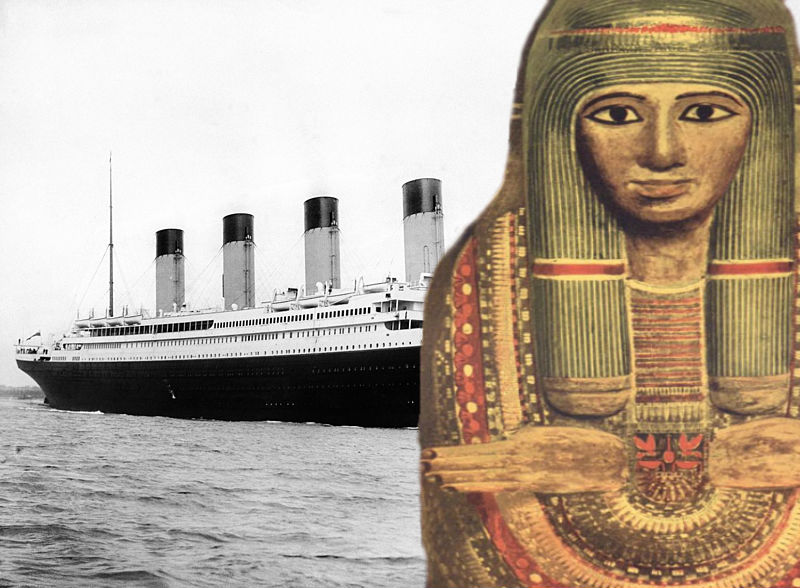There seem to be as many mysterious or haunted artifacts discovered and removed from the tombs of ancient Egypt as there are myths and legends about the sinking of the Titanic, and perhaps the most compelling of them all is the story that combines them: a mummy said to have sunk the ship of dreams.
Of course a mummy didn’t sink the Titanic. Shipping records show that there was never a mummy on board the ship, nor did any Titanic survivor testify to sharing a lifeboat with a mummy. The Unlucky Mummy, as this artifact is famously known, is in the possession of the British Museum, and it undoubtedly remained safe and sound in the museum quarters during the time of Titanic‘s ill-fated maiden voyage across the Atlantic. But how did such a story become so widespread?
The Unlucky Mummy was taken from Egypt to Britain during the last decade of the 19th century. The strange artifact, which is only a wood-and-plaster mummy board (perhaps an inner coffin lid) and not containing an actual mummy, has inscribed hieroglyphs that suggest its owner had once been a high priestess of Amen-Ra. Since its finding in the 1880s, the artifact has been shrouded in mystery. “It was seen to picture a woman’s face, of strange beauty, but of a cold malignity of expression,” wrote newspapers of the day.

The haunting stories would gain momentum as soon as the artifact was purchased by amateur archaeologist Thomas Douglas Murray. He acquired the case, in quite good condition, after striking a deal in Egypt. A couple of days later, as Murray had been shooting ducks at some point down the Nile, and just shortly before embarking on his return trip to Europe, he suffered an accident with his weapon, ending up with an injured arm. Before he was able to find proper medical treatment, the condition of his arm severely deteriorated and he lost it to amputation. Hence, he became the first “victim” of the mummy.
Other members of Murray’s expedition to Egypt were supposedly not spared misfortune. As Montague Summers affirms, after conducting in-depth research on witches, vampires, and magic in the early 1900s, “Two servants who had handled the mummy case, perhaps without sufficient respect, both died within a twelvemonth, whilst a far swifter fate overtook a third who had made some jesting sally.”
According to all the stories, misfortune followed almost everyone who came in contact with the mummy board since its arrival in Europe. Such is the case with Ms. Warwick Hunt. She had received the artifact as a gift, and since the moment the valued item found shelter under her roof, Ms. Hunt had undergone considerable financial losses. Eventually, she became the person who donated the mummy case to the British Museum.

All the rumors that surrounded the mummy prompted journalists, such as Bertram Fletcher Robinson, to investigate the nature of the artifact. Was it cursed indeed? Robinson had reportedly verified some of the stories’ truthfulness, but as it happened, before he was able to finalize any piece summing up his investigation efforts, he all of a sudden passed away.
Into the story came famous people, among others Sir Arthur Conan Doyle, who contemplated how strange Robinson’s death was. Perhaps the famed writer did not want to miss out on a good detective story, but he would not lose the moment to comment on Robinson’s death. That turned out to be “It was caused by Egyptian ‘elementals’ guarding the female mummy, because Mr. Robinson had begun an investigation of the stories of the mummy’s malevolence.”
Doyle had reportedly also warned Robinson about the mummy, but the journalist had continued his work anyway. The writer would further note: “The immediate cause of death was typhoid fever, but that is the way in which the elementals guarding the mummy might act.”
When Robinson had carried out his investigations, the artifact was already in the British Museum, which is where it is to date, and where it was a couple of years later, after Robinson’s death, when the Titanic sank. It is not entirely clear how the stories spread around that the case was on board the ocean liner, but some accounts point to the names of Murray and that of his friend, the famed journalist William Stead, who, unfortunately, happened to lose his life in the Titanic disaster.
Like many other people in the late 19th century and early 20th, Murray took an interest in the paranormal. He had at one point heard a story being shared around that told of a woman in England who also had a mummy imported from Egypt. After the woman had displayed the mummy in one of her rooms, the following day, everything breakable in that room was found shattered to pieces. That kept happening in other corners of the house, no matter where the woman relocated the mummy.
The story brought his attention back to the mummy case he had brought from Egypt, by now resting among the museum possessions. Along with his journalist friend Stead, they went to check on the case where it was displayed in the museum.

Stead was also attributed for coming up with some of the first news pieces about the curse of the mummy. After scrutinizing the artifact, they had “felt the expression on the face of the cover was that of a living soul in torment.” Allegedly, the pair then wished to perform the séance to remove “the anguish and misery from the eyes of the coffin-lid,” but such an offer was turned down by museum officials. Papers still issued some more stories on the mummy case.
In 1912, Stead found himself on board the Titanic as a first class passenger. He had embarked on this journey due to participating in a congress at Carnegie Hall. He was invited there personally by President Taft. His investigative journalism work by that point had been so well-recognized that he was even a candidate for collecting a Nobel Prize for Peace later that same year. He might have, but he didn’t make it. He was last seen reading a book in the smoking room of Titanic‘s first class quarters.
Following his death, a testimony made by one of the survivors appeared, saying that Stead had shared the story about the curse of the mummy case on board the Titanic in the days before the tragedy happened. Then, some claims popped up that the British Museum had allegedly wanted to remove such an unfortunate item from its possessions. The fake news also shared that the museum had arranged to sell the mummy case to a museum based in America, which is why the case supposedly found itself on board the lavish ship. Presumably, it was also the reason why the Titanic hit the iceberg and broke into two pieces.
The truth is very simple, however. The coffin of the high priestess never left the British Museum, but an excellent haunting story and some journalism apparently went a long way.
